KODIAK SEA LOUSE
A number of years ago while fishing several streams on Kodiak Island for Dolly Varden we had trouble getting them to take anything. The bottom was literally black with them and they could be seen flashing in the pools as they fed, yet they would not take anything. An ordinary Pheasant Tail Nymph was the only thing that occasionally worked. A few were kept for dinner one night and the stomach contents were amazing; there were sea lice in the stomachs, only sea lice, and lots of them.
A week later a fresh school of silver salmon (Coho) moved into an alder-shrouded pool and I crawled up to the edge of the hole to take a peek. The big salmon hung within a yard of my hiding place and I just watched them for a while. There were dollies all around them and they regularly slipped in and rammed the salmon just above the vent. They have been known to do that for years and conventional wisdom claims "They are loosening up the eggs."
Then I noticed the numbers of sea lice on the closest salmon had been reduced from five obvious lice to just four. So I watched more intently and it took quite a while, but eventually a dolly came in, rammed the silver and when it backed away there were just three. Conventional wisdom says the sea lice fall off the salmon pretty fast upon entering freshwater, but salmon in waters with less dollies seem to hang onto their sea lice for quite a while.
Through the course of the next hour or so several more dollies managed to pick a nit and proved it was not just a fluke.
So the need to find a sea louse pattern began. There were hot glue bodies formed on the hook and painted with nail polish, Swiss straw lumps, and Mylar bumps, and none really did anything. Even the idea of using a salmon-shaped and painted planing board with a fly holder in the right area was thought of, though at least partly in jest.
Nothing magic happened to allow discovery of a great Sea Louse pattern, it was just playing with a scud to look more like a louse and suddenly it made a difference! Changes since the initial pattern have made it much more effective; with blended UV Ice Dub colors and the glass bead eyes. In the end stages of the life of a Kodiak Sea Louse fly the body is tattered and the dubbing hangs in shreds and the eyes remain prominent while the fish continue to take them relentlessly.
In lakes it is best fished with fairly fast strips mixed greatly in length and timing. Keeping the line tight is a good idea to prevent missed strikes. Downstream and across, waiting for the bite on the swing is my usual method on streams, but deeper, slower water usually requires a bobber ("indicator" for the snobs) to work best.
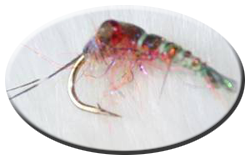
Materials:
- Hook: Continuous Curve nymph hook, sizes 8-12
- Thread: Chartreuse GSP 50 (also used for rib)
- Antennae: Two fibers of Guinea hen hackle
- Back: Green or gray Mylar scudback cut 3/16" wide
- Eyes: Silver-lined red beads strung on heavy mono burned at the ends
- Body: Olive, Pink, Red, and Pearl Ice Dub (~3:1:1:1) blended
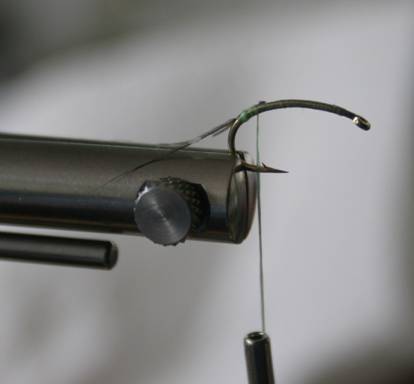
Start with a good thread base wrapped well down the hook bend and tie in the antennae. I like to capture the pair and then pull the closer one to me before the second wrap of thread to both flair them and hold them that way.
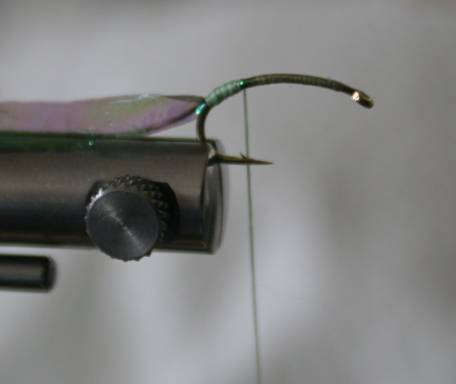
Taper-cut and tie in the scudback by just the point. Add some Sally Hansens now to keep everything strong.
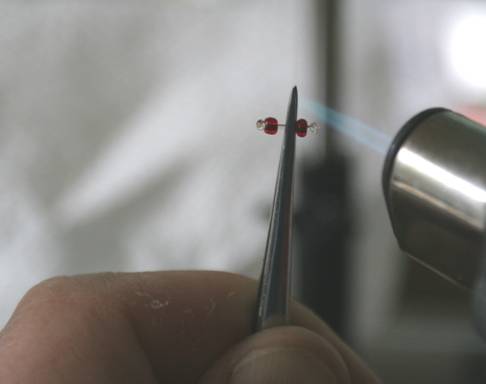
Thread two red, silver-lined beads on a piece of 40lb mono and burn the ends to stop the beads. Tweezers will allow you to hold the mono without burning yourself. Molten mono will leave a mark!
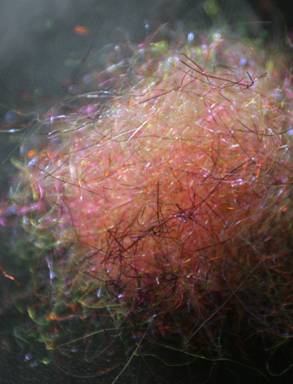
Now tie in the eyes over the middle of the barb. A series of X-wraps followed by several horizontal wraps around the base of the thread tie-in will hold it in place very well. Blend the Ice Dub thoroughly by hand. A blender will often melt synthetic dubbing and it only takes a couple minutes to blend enough for many flies. A zip-lock and a shot of compressed air is also effective.
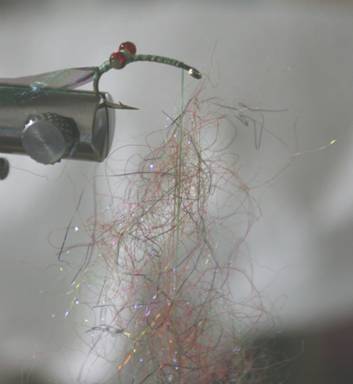
Split your thread with a bodkin and insert a small amount of dubbing between the thread halves. Keep it sparse to the top and slightly thicker as you go down. Adjust it until most is within the thread halves and then spin it tight.
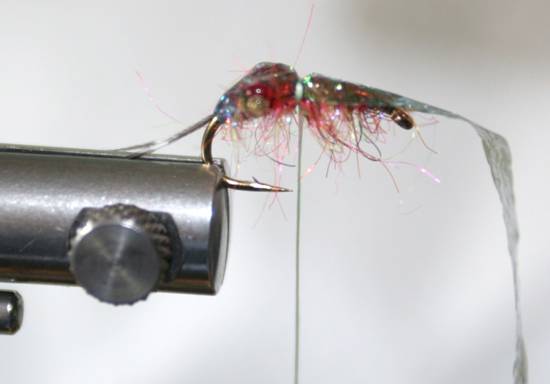
Wrap the dubbing thread all the way forward and then back making sure the eye wraps are completely covered and bring your thread to about1/8" behind the eyes.
The scudback is now pulled back over the body and captured by a wrap of thread. Stack another thread wrap exactly atop the first and continue to the eye with gradually closer wraps to create a tapered body. At each wrap around the body double the wraps.
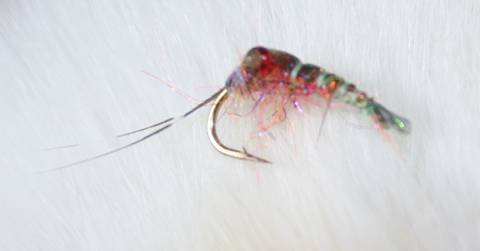
Lift the remaining scudback and tie-off the thread at the eye of the hook, under the scudback. Trim the thread and cut the scudback so it just covers the eye of the hook. Brush the dubbing out along the belly and the fly is done.
For more great info, check out:
Beginning Fly Tying | Intermediate Fly Tying | Advanced Fly Tying.
